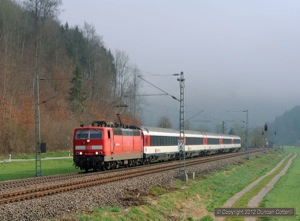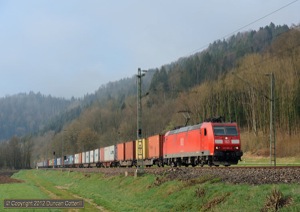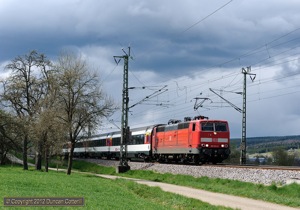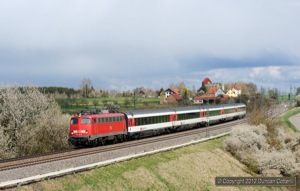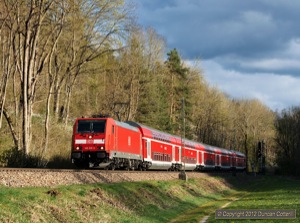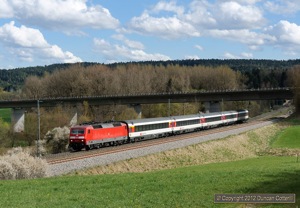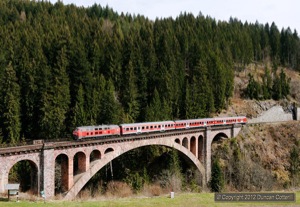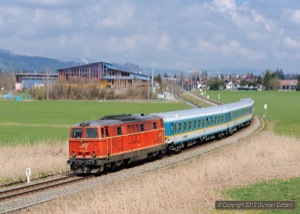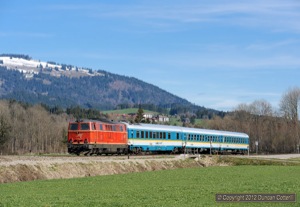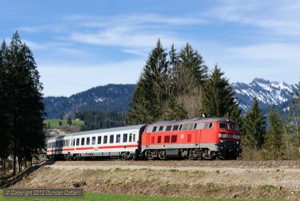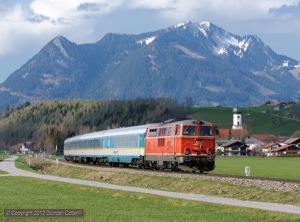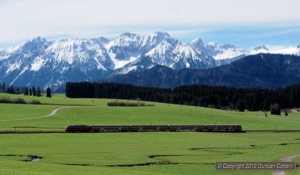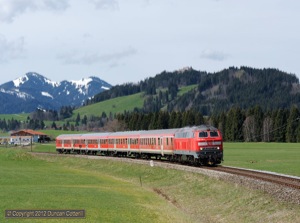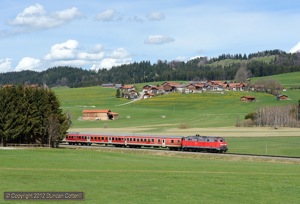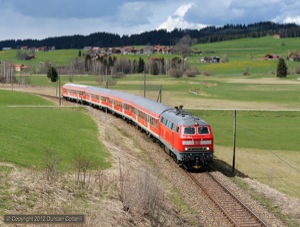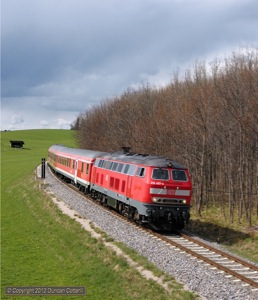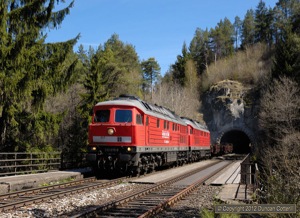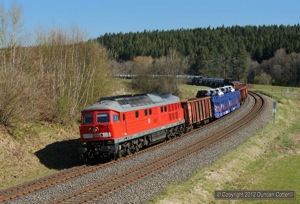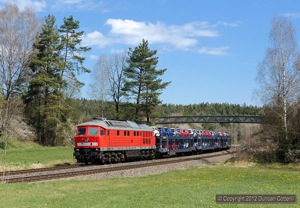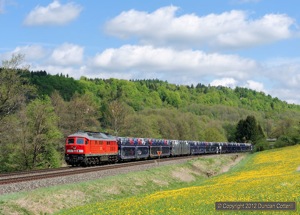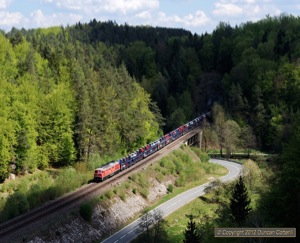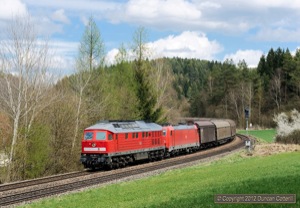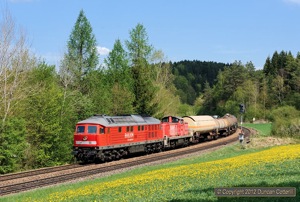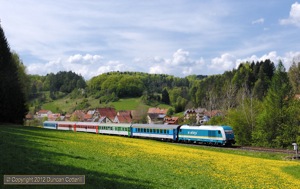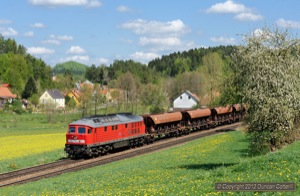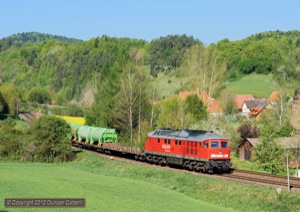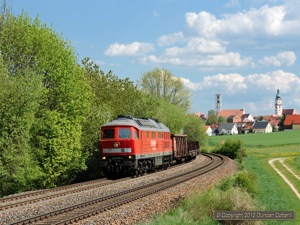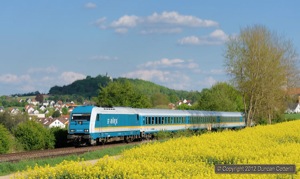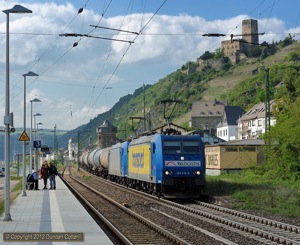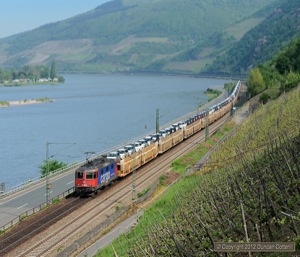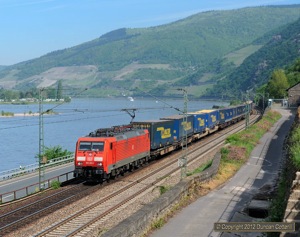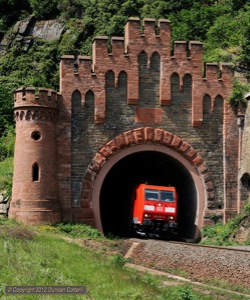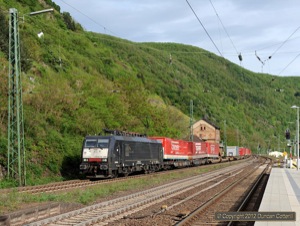South German Spring
12 April - 09 May 2012
Report by Duncan Cotterill
Introduction
This report details a four-week photographic trip to southern Germany in April and May 2012. The itinerary was deliberately kept flexible in order to cope with unpredictable events, such as engineering work and, of course, the weather. In the event, it was the weather that caused almost all the problems.
My top priorities were the class 115 and 181 hauled passengers that run on the Stuttgart – Singen line at weekends and the class 232 hauled freights on the lines east and north-east of Nürnberg. I also visited the Oberstdorf and Füssen branches in the Allgäu region of Bayern, the Ceske Budejovice – Nove Udoli line in the Czech Republic (separate report) and the Rhein Gorge.
Travel was by car from the UK via the Channel Tunnel and accommodation was booked on the web as I went around via www.booking.com.
This section of the report summarises what was seen. For train by train details with loco numbers etc, go to the Day by Day pages.
Stuttgart – Singen
(Thu 12 – Mon 16 and Fri 20 – Mon 23 April 2012)This Stuttgart – Zürich Inter City service has seen the most remarkable transformation over the past few years with ICE3 tilting EMUs replaced by conventional loco hauled trains running at 2-hourly intervals. This year four different classes are booked to work these services over the Gäubahn between Stuttgart and Singen, where SBB Re4/4II take over. During the week class 101 and 120 share the duties but from Thursday evening to Sunday classes 181 and 115 (DB Autozug class 110) are also booked to work some trains. In practice the 115s were often substituted by class 110s but otherwise everything I saw was worked by the booked locos.
Booked Classes on Stuttgart - Singen ICs
| Train no | 181 | 183 | 185 | 187 | 281 | 283 | 285 |
|---|---|---|---|---|---|---|---|
| ex Stuttgart | 07:56 | 09:56 | 11:56 | 13:56 | 15:56 | 17:57 | 19:56 |
| Mo | 101* | 120 | 101 | 120 | 101 | 101* | 101 |
| Tu | 101 | 120 | 101 | 120 | 101 | 101* | 101 |
| We | 101 | 120 | 101 | 120 | 101 | 101* | 101 |
| Th | 101 | 120 | 101 | 120 | 101 | 101* | 115 |
| Fr | 181 | 101* | 120* | 115 | 181 | 101* | ? |
| Sa | 181 | 101 | 120 | 101 | 101 | 101 | 101 |
| Su | 115 | 101 | 101 | 115 | 115 | 101 | 101 |
Booked Classes on Singen - Stuttgart ICs
| Train no | 284 | 282 | 280 | 186 | 184 | 182 | 180 |
|---|---|---|---|---|---|---|---|
| ex Singen | 08:10 | 10:10 | 12:10 | 14:10 | 16:10 | 18:10 | 20:10 |
| Mo | 101 | 101 | 101* | 120 | 101 | 120 | 101 |
| Tu | 101* | 101 | 101 | 120 | 101 | 120 | 101 |
| We | 101* | 101 | 101 | 120 | 101 | 120 | 101 |
| Th | 101* | 101 | 101 | 120 | 101 | 120 | 101 |
| Fr | 101* | 115 | 181 | 101* | 120* | 115 | 181 |
| Sa | 120 | 101 | 181 | 101 | 120 | 101 | 101 |
| Su | 101 | 101 | 115 | 101 | 101 | 115 | 115 |
- Bold indicates confirmed by actual sighting.
- Turns shown as 101* also appear in the 120 diagrams but every one I saw was 101 hauled.
- Turns shown as 120* don’t appear in the 120 diagrams (or any others that I’ve seen) but were 120 hauled when seen.
The line also sees a number of freights, almost exclusively hauled by DB class 185s. A local enthusiast I spoke to gave me the following schedule, based on his observations. Times are for Sulz am Neckar and proved to be pretty accurate ….
08:00 NB Freight Mo – Sa
09:00 NB Containers Mo – Sa
09:40 SB Freight Mo – Fr
12:00 NB Freight Tu – Sa
15:50 SB Steel Tu + Th
18:00 SB* Freight Tu – Fr + Su
* I was told this was a northbound but regularly saw a southbound at this time.
The line runs through really attractive scenery on the eastern fringes of the Black Forest with the section through the Neckar Valley from Horb to Rottweil being particularly photogenic. The landscape, combined with the variety of traction, makes this line irresistible for photography. Unfortunately the weather did its best to thwart my efforts. The first weekend produced a single shot of a 181 in sun while the second bagged two 181 shots and a 110. Better than nothing but not a good return from a potential 26 photographable trains worked by the two classes over the six full days I was there.
There’s a lot of preservation activity in the area with a collection of 26 steam locos and a 228 diesel in the old Tuttlingen depot, now Eisenbahnmuseum Tuttlingen. Many of the locos are visible from passing trains. There’s also a new museum just south of Horb, which appears to contain a number of diesels and electrics including a 110, a 144, a 217 and an SBB Ae6/6 as well as a class 44 2-10-0 and various EMUs and DMUs. The old Rottweil depot also appears to be used by a preservation group with the yard stuffed with old coaches awaiting restoration.
One line I remembered from almost 40 years ago was the Trossinger Eisenbahn, a short electrified line that used ancient electric railcars to link the town of Trossingen with Trossingen Bahnhof on the Rottweil - Villingen line. I was surprised to see the electrification was still in place but disappointed to find the service provided by modern diesel railbuses. Apparently much of the old stock is preserved and is occasionally allowed out on special trains.
Ulm - Neustadt (Schwarzw)
(Sun 15, Sat 21 April 2012)This long cross-country route is normally worked by class 611 tilting DMUs but on Saturdays and Sundays there is a 218 working from Ulm to Neustadt on IRE3220, then to Rottweil via Villingen on RE22304, then back to Neustadt on RE22311 and finally IRE3225 back to Ulm.
Between Donaueschingen and Neustadt the line climbs out of the Donau Valley to a summit more than 800m above sea level in the heart of the Black Forest. There are a number of photo positions on this section including shots passing semaphore signals at Döggingen and Löffingen stations and the impressive Gutachbrücke a few km before Neustadt. At Neustadt the line makes an end on connection with the electrified Höllentalbahn from Freiburg, worked by class 143 electrics.
Immenstadt - Oberstdorf
(Mon 16 – Thu 19 April 2012)ALEX services from München to Lindau and Oberstdorf split at Immenstadt with a hired ex-ÖBB class 2143 taking the Oberstdorf portion forward. The loco used is one of three owned by Augsburg based SVG. The ALEX service operates on a two-hourly cycle with the 2143 performing the shunt to combine portions at Immenstadt and running round at Oberstdorf.
The line also sees DB class 218s on two daily InterCity train pairs, going north in the morning and south in mid to late afternoon. There are also a handful of Regio push-pull workings with the loco at the Immenstadt end of the set. Most of these run in the early morning and the evening but there are better timed trains on Saturday and Sunday mornings. The majority of Regio workings are operated by class 612 and 628 DMUs. There is no regular freight traffic.
This is a very scenic line running down a broad valley surrounded by the peaks of the Allgäuer Alps. Despite their proximity, it isn’t easy to include the mountain peaks in the photographs but, even without the snowcapped peaks, the picturesque landscape makes a great setting for railway photographs.
The 2143 was the main attraction for me and I was pleased to find red liveried 2143.21 in use. The other two locos are in SVG’s dark blue livery, attractive but not as nice as the red one.
Once again, the weather was a major limitation but there were enough sunny breaks over the three days I was there to ensure I got a reasonable selection of shots of the 2143 as well as a few of the 218 hauled IC services.
Biessenhofen – Füssen
(Wed 18 – Thu 19 April 2012)There are more loco hauled trains on the Füssen branch this year with class 218 worked push-pull sets on approximately 75% of services. Around half the two-hourly RB trains from Augsburg are DMUs of classes 628 or 642 but the two-hourly München RE trains and the remaining Augsburg RBs are locos, invariably at the Füssen end of four coach push-pull sets. There is no regular freight traffic.
This was my first attempt at photography on the line. I’d done a recce by train in late 2010 and it wasn’t very difficult to find reasonable photo positions. The first 2km south from Weizern-Hopferau were particularly good and, as this section is almost east-west, it’s a good fit with doing the morning and evening trains on the Oberstdorf branch. The journey between the two lines takes well under an hour by road. Other positions were found either side of Seeg but potential positions further north looked a bit ordinary.
After spending much of 18 April checking positions in the gloom, I returned the following day and got several shots in sun.
Nürnberg – Marktredwitz and Schwandorf
(Mon 23 – Sat 28 April and Wed 02 – Sat 05 May 2012)These two scenic, double-track, diesel-worked routes cross the Fränkische Alb uplands east of Nürnberg and still carry a fair amount of freight traffic, worked by DB class 232 and 233 diesels.
The Schwandorf line carries a mixture of online and through traffic including international freight to/from the Czech Republic via Furth i Wald. Coal and steel go to the foundry at Luitpoldhütte near Amberg and the pipeworks at Sulzbach-Rosenberg Hütte and there is a significant flow of domestic waste to the incinerator at Schwandorf.
Regular trains at Etzelwang include an eastbound around 09:30 (Mo – Sa) and westbounds around 15:20 (Mo – Fr) and 16:00 (Mo – Fr). Additional trains seemed quite common in the afternoon with a westbound block train of PKP coal hoppers appearing on several occasions sometime between 14:00 and 15:30. An eastbound steel train also ran more than once around the same time. There were also a few freights diverted from the Regensburg – Nürnberg line due to engineering works and one of these still had the class 185 electric attached.
The Marktredwitz line doesn’t have any significant online traffic and through freights to/from the former DDR via Reichenbach and Hof appear to have decreased markedly since last year. This may well be due to ongoing electrification work north of Hof. Traffic to/from the Czech Republic via Cheb seemed buoyant with most of the expected trains running.
Traffic was less reliable than on the Schwandorf line but the more dependable workings at Vorra included a southbound freight from Cheb around 08:30 and a southbound car train around 12:00. There was often a southbound ballast train or a train of rails just before or after the cars. An early afternoon freight to Cheb tended to run around two hours early, passing Vorra around 12:20 and the mid-afternoon freight from Cheb also ran much earlier than it’s 16:30 booked time on one of the two occasions I saw it.
Booked times for freights on both lines were obtained from www.cargonautus.de
The only loco hauled passenger services on either line are three ALEX trains in each direction between Nürnberg and Schwandorf, worked by class 223 diesels. Two of these train pairs are through workings to/from Praha via Furth i Wald, which the ALEX loco works to/from Plzen, and the third consists of early morning and evening positioning moves to get the loco and stock from/to Schwandorf, where ALEX has a base. ALEX also has a number of loco hauled workings on the nearby Regensburg – Schwandorf – Marktredwitz – Hof route.
Heavy diesel hauled freights are becoming increasingly difficult to find in Europe and these two lines are rare gems with reasonable traffic volumes, excellent photo locations and attractive locomotives. The last point may be stretching it a bit but compared to Voith Maximas or Class 66s, Ludmillas are gorgeous!
One of the biggest uncertainties when photographing freights is knowing when or if a train will turn up. Even if you know the booked times, freights can run very erratically. Timekeeping on these lines was remarkably consistent and even the trains that ran early were usually consistently early. As an example of reliability, the morning freight was seen near Etzelwang on four occasions at 09:27, 09:36, 09:28 and 09:28. This consistency made it possible to switch from one line to the other with some degree of confidence that a train would turn up at the appropriate time. This strategy didn’t always work but it usually did.
Like the rest of the trip, the weather was mixed here. Fortunately the worst conditions occurred early in the trip, giving me the opportunity to travel the lines by train looking for new locations to visit on subsequent days. In the event, it took most of the trip to get the shots I already knew about and most of the new locations will have to wait for next time, assuming the Ludmillas last long enough for there to be a next time.
Between the two sessions in the Nürnberg area, I spent a few days on the Ceske Budejovice – Nove Udoli line in the Czech Republic (report here).
Rechte Rheinstrecke
(Sun 06 – Tue 08 May 2012)After spending much of the trip visiting lines where the interesting trains were relatively infrequent, I finished off on what should have been one of the busiest lines in Germany. The electrified main line from Koblenz to Wiesbaden runs along the right bank of the Rhein through the famous gorge and normally carries a high volume of freight traffic.
During the first two days of my visit, freight volumes were very low with far more trains running on the opposite side of the river. On the Sunday this was obviously due to engineering work and single line working between Rüdesheim and Kaub but the reason on the Monday was less obvious. On the Tuesday things returned to normal with 57 freights noted in 10 hours, plus a few that I missed while switching locations.
DB class 185s handled far more trains than any other type but DB locos of classes 140, 145, 151, 152, 155 and 189 were also seen. SBB Cargo’s attractive red and blue livery was also a common sight with a number of class 482 (class 185) seen as well as a class 421. On the Monday two class 420s and two class 474s went north light engine.
As would be expected, independent operators had a big presence with Crossrail and Dispolok locos most common. The independents mostly used modern machines of classes 182, 185, 189 etc, but it was good to see a former DR class 142 as well.
Passenger traffic was entirely worked by Class 427 and 428 “Flirt” EMUs operated by VIAS.
Fortunately the best weather occurred on the Tuesday when traffic was busiest, enabling me to get many of the shots I wanted in a single day. There’s still more to do in the Rhein Gorge and another visit is inevitable, particularly as the area makes a convenient stopping off point en-route from or to the UK.
Linke Rheinstrecke
(Sun 06 – Wed 09 May 2012)Although I only spent a few hours on the line on the Wednesday morning, I could see much of what was going on across the river on the other three days.
The Koblenz – Mainz main line carries a much wider variety of passenger traffic than the line on the right bank with ICEs, loco worked ICs and REs and class 460 EMUs on local services. The ICs/ICEs operate to an hourly schedule, half hourly at busier times, with the majority of trains loco hauled, or propelled, by class 101s. ICEs operate a minority of services and there are a handful of class 120 workings as well. All the REs seen were worked by top’n’tail class 143s on three or four coach double-deck rakes.
The most interesting passenger train seen was an unidentified southbound working that passed Treuchtingshausen at 09:40 on Monday and was seen again, north of Mainz, just before 10:00 on Wednesday. Motive power was an immaculate class 103 on a matching rake of red and cream stock.
There was a fair amount of freight on the line on the Sunday and Monday when the line on the right bank was quiet. On Tuesday, when the right bank got busy again, the volume of freight traffic dropped dramatically. It would be surprising if the events weren’t linked.
Comments and Conclusions
This was a difficult trip with poor weather causing much replanning along the way. Lower priority destinations such as the Ulm – Lindau, Basel – Baden, Treuchtlingen - Ingolstadt and Regensburg – Marktredwitz lines were dropped to allow more time on Stuttgart – Singen and the lines east of Nürnberg. In the end I got many of the shots I really wanted, eventually. The exception was Stuttgart – Singen, which is now top priority for a return visit.
Despite the weather, I still think Spring is one of the best times for a photographic trip to central Europe, particularly if you’re lucky enough to be there at the moment the landscape bursts into life with vibrant greens on the trees and the meadows covered in yellow flowers. Railway photography is about so much more than just the train. Good lighting, a pleasing composition and an attractive setting are also vital components in making a satisfying photograph and catching the landscape at its most attractive is a great help.
Although I travelled by car for speed, flexibility and convenience, it would be possible to do all of the photo locations I used by train and walking. Even the most remote position was within an hour’s walk of the nearest station. It was also forty minutes walk from where I had to park. Most locations were within two or three km of a station, meaning a walk of only 20 - 30 minutes.
Finally, thanks to those who supplied tips about the photo positions at Ranna and in the Rhein Valley and those who compile the diagrams for V160, ERG and CDGen and the freight timetables. They really do make planning a trip and deciding where to go on the day a lot easier. Keep up the good work.
